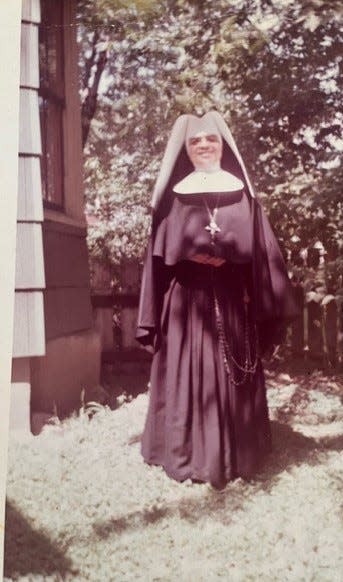Black Catholic History Month provides chance to reflect on contributions to Elmira
On July 24, 1990, the National Black Catholic Clergy Caucus of the United States designated November as Black Catholic History Month to celebrate the long history and proud heritage of Black Catholics.
“November marks a time when the church prays for all saints and souls in loving remembrance as well as a time to recall the saints and souls of Africa and the African Diaspora,” according to the Catholic University of America.
The decision also depended on the fact that a number of important dates to Catholics of African descent fell within this month:
Nov. 1, All Saints Day: An opportunity to review the lives of the hundreds of Saints of African descent in the first 300 years of the church.
Nov. 2, All Souls Day: A time to remember all those Africans lost to cruel treatment in the Middle Passage crossing the Atlantic Ocean.
Nov. 3: Martin de Porres became the first black American saint. He was canonized by Pope John XXIII on May 16, 1962.
Nov. 13: The birth of St. Augustine in 354 A.D. the first Doctor of the Church from North Africa
Nov. 20: The death of Zumbi of Palmares in Brazil, South American founder of a free state for Blacks.
According to the United States Conference of Catholic Bishops, there are over three million African American Catholics in the United States today, there are 250 African American priests, 437 deacons, and 75 men of African descent in seminary formation of the priesthood in the United States. There are seven living African American bishops, of whom two head U.S. dioceses. The Archbishop of Washington was elevated to the College of Cardinals in 2020.
The late Rev. (Bishop) Cephus McGee, pastor of All Saints Home Church of God in Christ, once told me that the most segregated time in Elmira was Sunday morning. “Black folks go to the Black churches and white folks attend their churches.” He did not take note of the Black Catholic community.

In the “Parish History of St. Peter and Paul’s” Catholic Church, written in 1985, it was noted: “No history of the Mother Church of Elmira could be written without mention and also a tribute to all our Black Catholic Parishioners. One of our black families that have been with us the longest is the Davis Family … Mrs. Anna Davis moved to Elmira about 1914 with her three sisters and brother, Gabriel Smith, and attended our parish.”
Interestingly, one of Anna’s descendants, Francelia Emanuel Newman, told me that as a little girl she was not allowed to attend a “Black Church” and did not hear a live gospel song until she was 13.
The Davis family can trace their history to their days of bondage on the Carrollton Manor near Frederick, Maryland. Maryland had been founded by Lord Baltimore as a haven for Catholics. The owners of the Manor were cousins of John Carroll, the first Catholic bishop and archbishop in the United States. For slaves on the manor, the Catholic faith was a way of life. Anna’s sister recalled that, “Old Mrs. Carroll taught my mother all her prayers and you couldn’t think of a single prayer she didn’t know.” (St. Peter and Paul Parish History, 1964)
Anna’s sister herself is a reflection of the deep Catholic faith in her family. Sister Isidore served 76 years in the Oblate Sisters of Providence. It was formed in 1829 in Baltimore, Maryland for the education of girls of African descent. It was the first permanent community of Black Sisters in the United States.
Anna and her family came to Elmira after her husband John Davis had passed away. They had five children. Their son Charles and his wife Elizabeth, who became church members in 1916, had 11 children, many of whom became faithful parishioners of St. Peter and Paul’s. Their oldest daughter, Theodora, the great niece of Sister Isidore, carried on the tradition of faith and service.
More: Elmira church transformed into 'one of a kind' events center, sports complex. Go inside.
Theodora married George Bragg, bringing him into the Catholic Church. George became a community leader, head of the NAACP, the head of the Elmira Housing Authority and the first African American to run for mayor of Elmira in 1973. Bragg Towers, the senior living center on Madison Avenue, is named in his honor.
Theodora also made a significant contribution to our community. She was selected as Black Woman of the Year by the YWCA in the year 2000. Her deep faith and commitment are reflected by her service. She was President of the Immaculate Heart Society, a member of the Ladies of Charity, Catholic Daughters of America, St. Joseph’s Auxiliary, volunteered at the Community Kitchen AND cooked and baked for the priests at St. Peter and Paul’s.
The month-long celebration of Black Catholic History serves to raise awareness about the rich history and cultural heritage of Black Catholics who have played a significant role in the development of the church and the fight for civil rights.
One only has to look at the Davis family of Elmira to appreciate that role: the Braggs, Clarks, Snowdens, Sampsons, Pannells, Ranseys, Emanuels, descendants of Anna and John, all of whom are practicing Catholics today.
— Jim Hare writes a monthly history column.
This article originally appeared on The Evening Tribune: Black Catholics have made important contributions to Elmira
